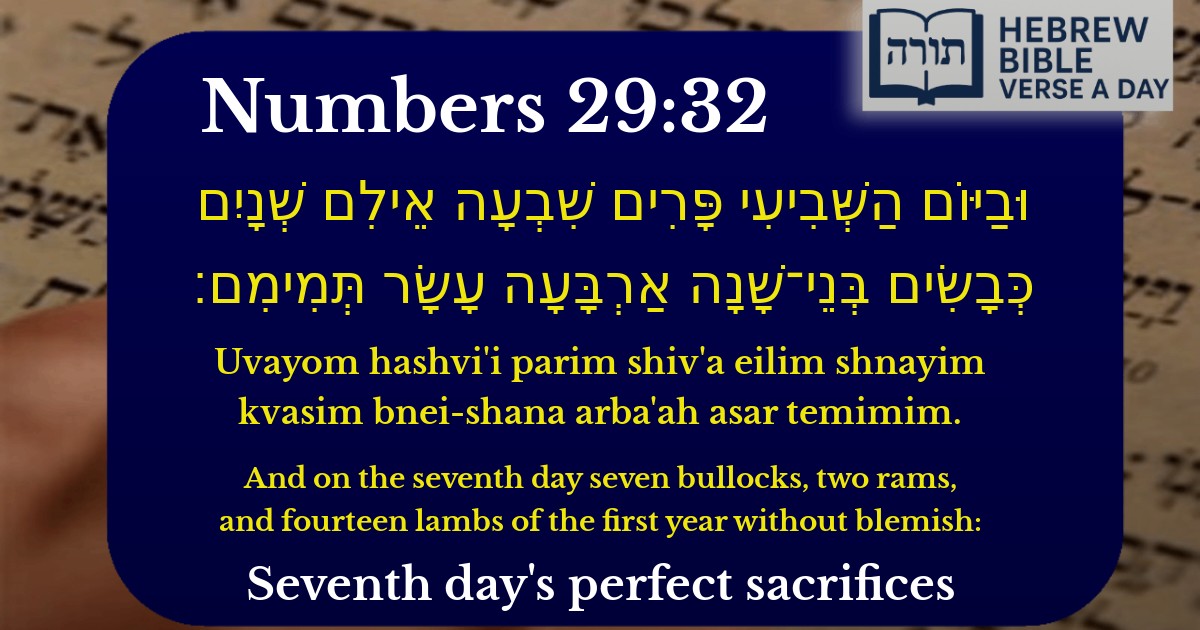Join Our Newsletter To Be Informed When New Videos Are Posted
Join the thousands of fellow Studends who rely on our videos to learn how to read the bible in Hebrew for free!
Hebrew Text
וּבַיּוֹם הַשְּׁבִיעִי פָּרִים שִׁבְעָה אֵילִם שְׁנָיִם כְּבָשִׂים בְּנֵי־שָׁנָה אַרְבָּעָה עָשָׂר תְּמִימִם׃
English Translation
And on the seventh day seven bullocks, two rams, and fourteen lambs of the first year without blemish:
Transliteration
Uvayom hashvi'i parim shiv'a eilim shnayim kvasim bnei-shana arba'ah asar temimim.
Hebrew Leining Text
וּבַיּ֧וֹם הַשְּׁבִיעִ֛י פָּרִ֥ים שִׁבְעָ֖ה אֵילִ֣ם שְׁנָ֑יִם כְּבָשִׂ֧ים בְּנֵי־שָׁנָ֛ה אַרְבָּעָ֥ה עָשָׂ֖ר תְּמִימִֽם׃
Parasha Commentary
📚 Talmud Citations
This verse is quoted in the Talmud.
📖 Menachot 45b
The verse is referenced in a discussion about the sacrifices offered on the seventh day of Sukkot, detailing the specific numbers and types of animals required.
📖 Chullin 60a
Mentioned in the context of discussing the laws and details of sacrificial offerings, particularly focusing on the requirements for animals to be without blemish.


Overview of the Verse
The verse (Numbers 29:32) describes the additional offerings (musafim) brought on the seventh day of Sukkot. These offerings include seven bulls, two rams, and fourteen unblemished lambs in their first year. This follows the pattern of decreasing bulls each day of Sukkot, as outlined in the preceding verses.
Rashi's Commentary
Rashi (Rabbi Shlomo Yitzchaki) explains that the number of bulls decreases each day of Sukkot (from 13 on the first day to 7 on the seventh day) to symbolize the gradual reduction of the nations of the world, as the 70 bulls correspond to the 70 nations. The consistent number of rams and lambs represents the steadfastness of the Jewish people in their service to Hashem.
Symbolism of the Numbers
Rambam's Perspective
In Moreh Nevuchim (3:46), Rambam (Maimonides) suggests that the sacrificial system, including these offerings, was designed to wean the Israelites from idolatrous practices by channeling their worship toward Hashem in a structured manner. The decreasing number of bulls reflects a spiritual progression away from pagan influences.
Talmudic Insights
The Talmud (Sukkah 55b) states that the bulls of Sukkot atone for the nations of the world, highlighting the universal role of the Jewish people as a "light unto the nations." The consistent lambs and rams signify Israel's unwavering commitment, even as the influence of other nations wanes.